Sourdough English Muffins
Sourdough English Muffins are surprisingly easy to make and soooo much better than store bought. The active starter in the dough makes the flavor and texture extra special. The recipe takes several hours, but there is very little hands-on time. Stock up the freezer for future breakfasts.
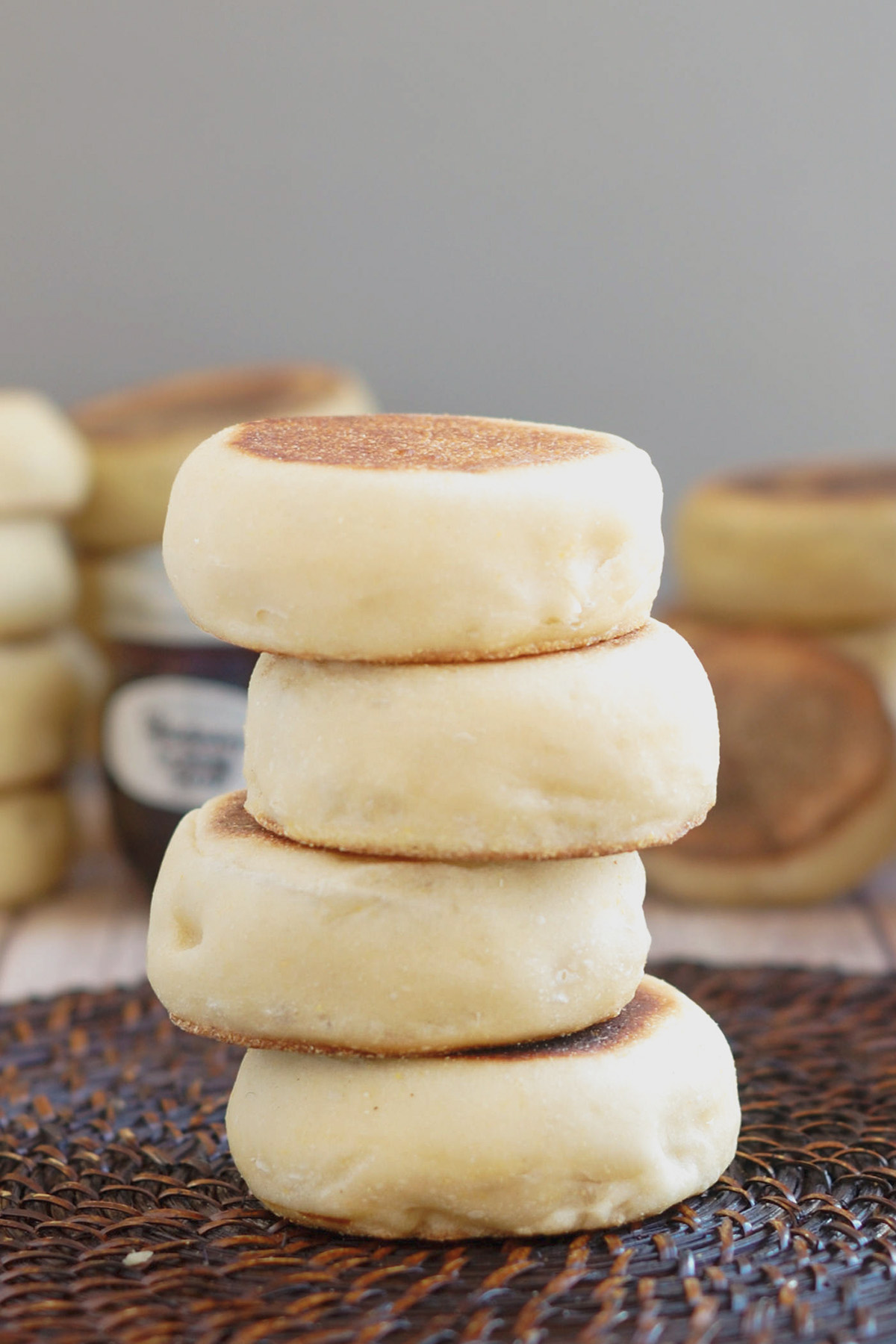
Table of contents
About this recipe
English Muffins are always toasted before eating. So use your starter to make Sourdough English Muffins for a later date. This is a perfect “make ahead and freeze” recipe.
If you don’t already have one, I can show you how to make a sourdough starter and how to feed a sourdough starter.
Ingredients
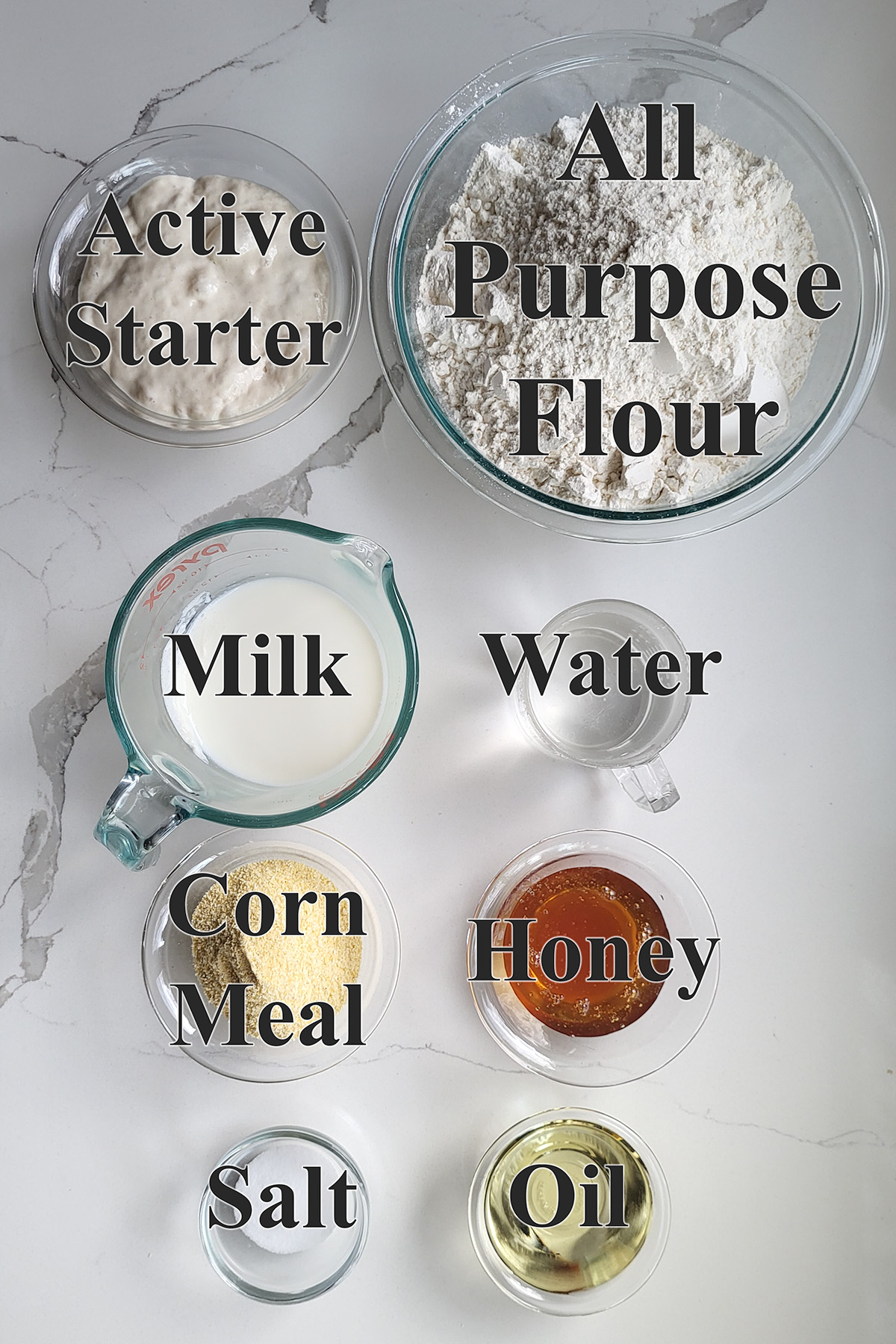
Ingredient Notes
- Sourdough Starter – The recipe was developed using 100% hydration starter. If your starter has a different hydration percentage you will need to adjust the amount of water or flour in the recipe.
- Unbleached All Purpose Flour – Medium content all purpose flour makes a dough with enough gluten for the muffins to rise. You may replace a cup of the all purpose flour with whole wheat or rye flour for whole grain flavor.
- Honey – You can substitute 1/4 cup (2 oz) of granulated sugar if you don’t have honey.
- Corn Meal – Rolling the dough on cornmeal gives the muffins the classic cornmeal dusted bottom crust. You can use flour for rolling if you don’t have cornmeal.
Process Photos
See the recipe card for detailed measurements and instructions.
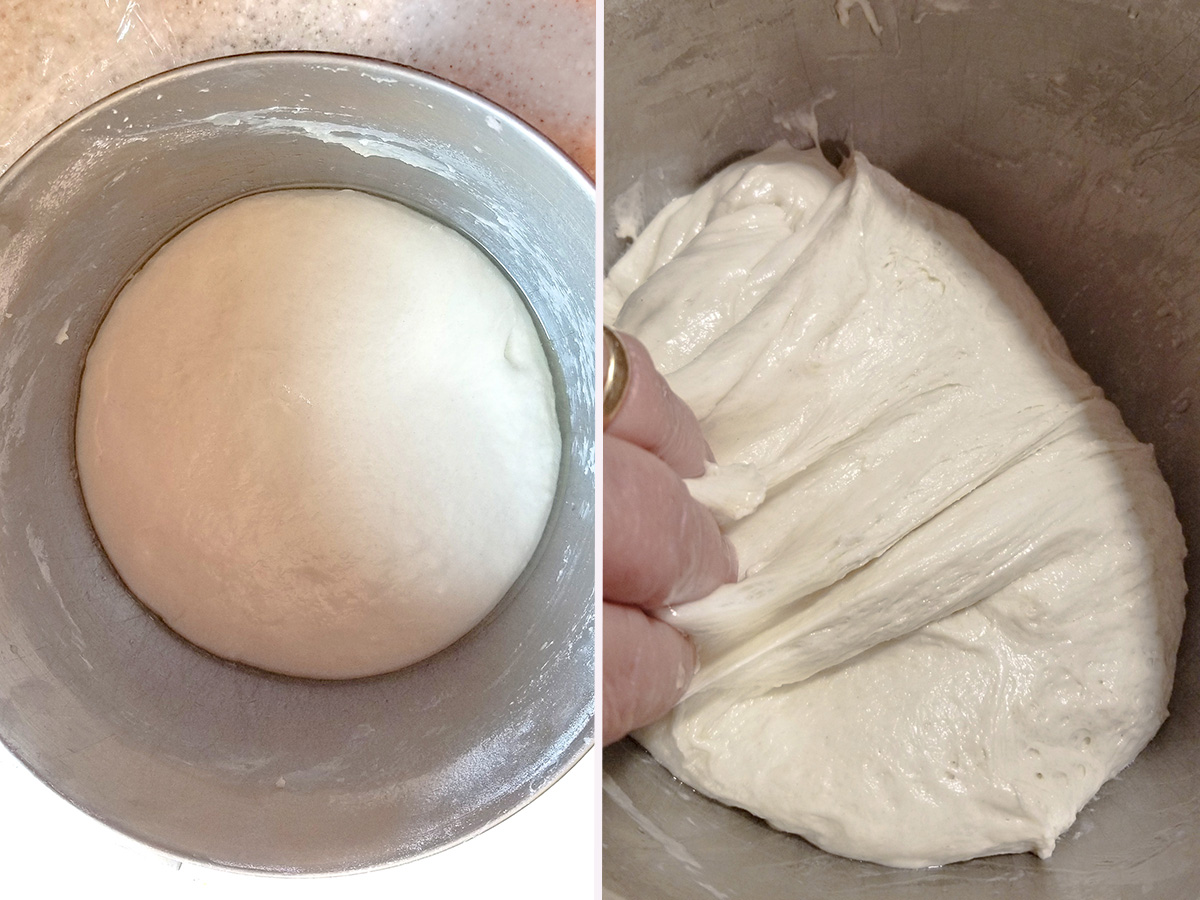
- After the dough is mixed set it aside at room temperature to ferment.
- Every hour fold the dough to develop the gluten and redistribute the yeast.
- The dough is ready when it is lively, light and elastic. This should take 3-5 hours.
- At this point the dough can be refrigerated for up to 2 days or you can proceed with cutting the muffins.
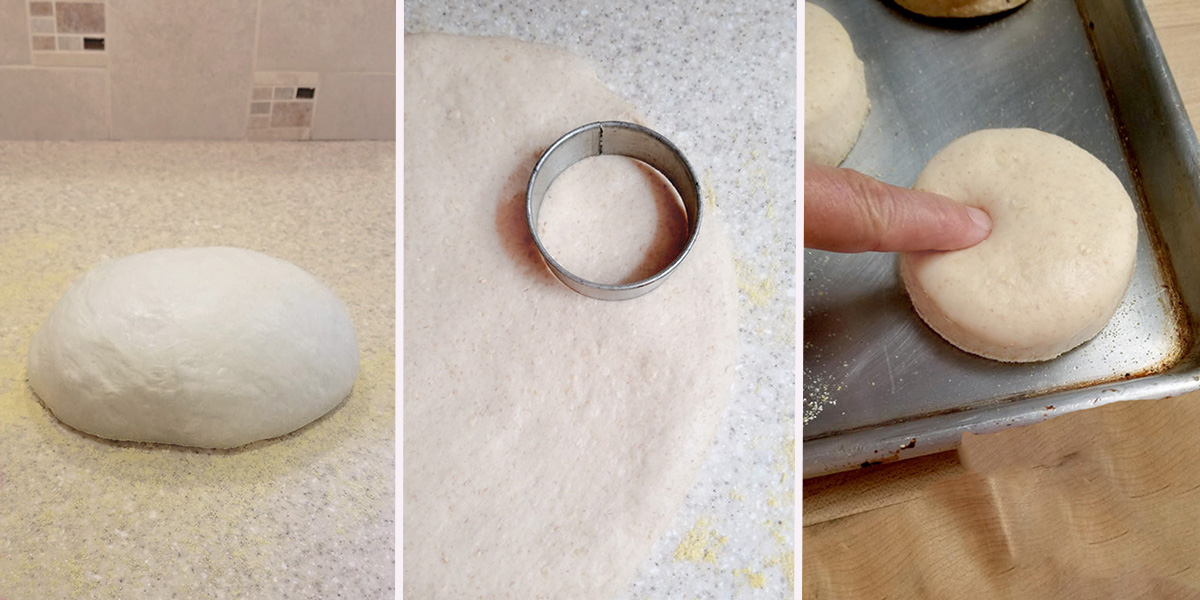
- Roll the dough to 1/2″ thick on a cornmeal dusted surface.
- Cut the muffins using a 3 – 3 1/2″ cutter. Line the muffins on a sheet pan. At this point you can wrap the tray and refrigerate overnight to bake the next day.
- Allow the muffins to rise for 1-2 hours. The rise time will vary depending on the temperature of the dough and the ambient temperature in the room.
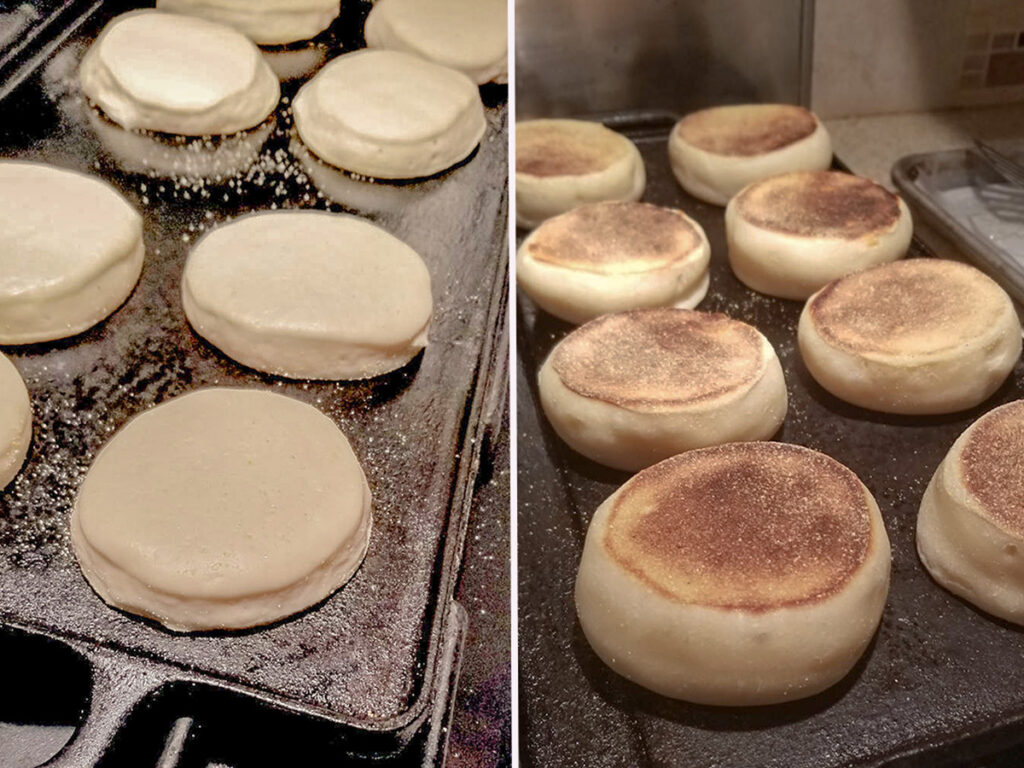
- Preheat a cast iron griddle or skillet over medium high heat.
- Set the muffins, cornmeal side down, on the pan. Leave 1″ space between muffins. Cook until the muffins rise up, brown on the bottom and the sides are mostly set, about 6-8 minutes. Adjust the heat as needed to keep a constant temperature.
- Flip the muffins and bake until the other side is golden brown and the sides are set, also about 6-8 minutes.

- Completely cool the muffins on a rack before packing into a freezer bag.
How to Serve Sourdough English Muffins
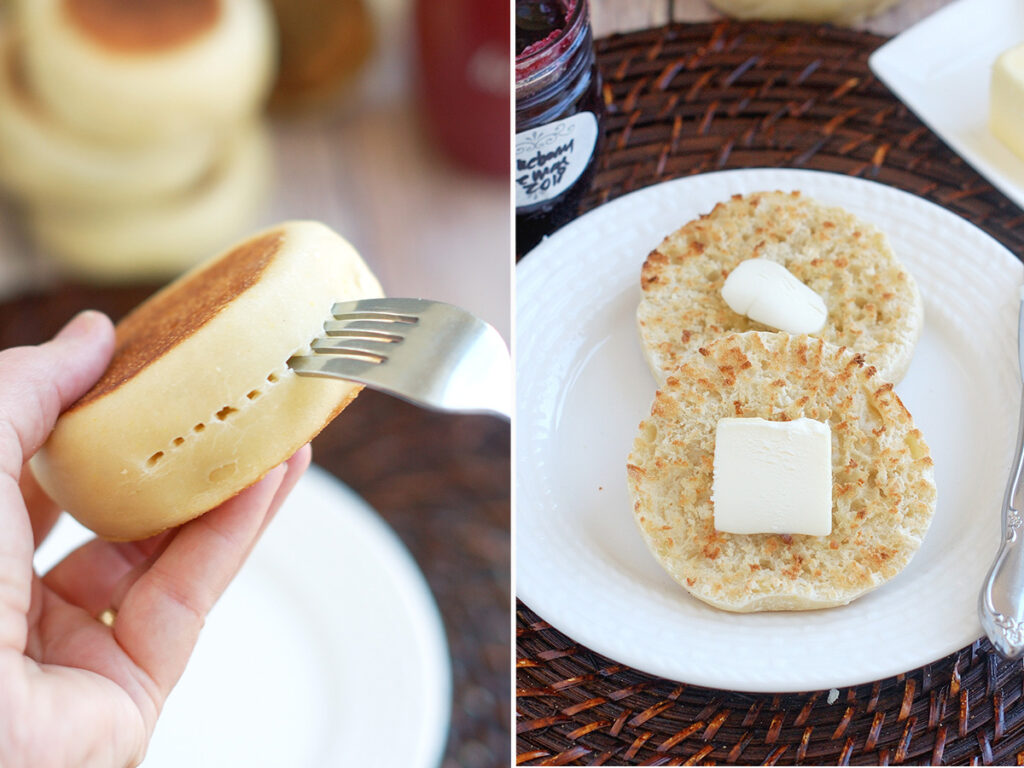
- Sourdough English Muffins should always be toasted before serving.
- To get the best texture don’t slice it with a knife! Use a fork to split the muffin.
- Fork-splitting forms the “nooks and crannies” that hold lots of melted butter.
Storage
- Fresh Sourdough Muffins will keep at room temperature for one day.
- For longer storage, pack the muffins into freezer bags and freeze up to 3 months.
- Microwave a frozen muffin for 10 to 20 seconds. Fork split the muffin, toast and serve.
I know you hate to throw away that sourdough discard. Check out these recipes that use sourdough discard.
More Sourdough Recipes:
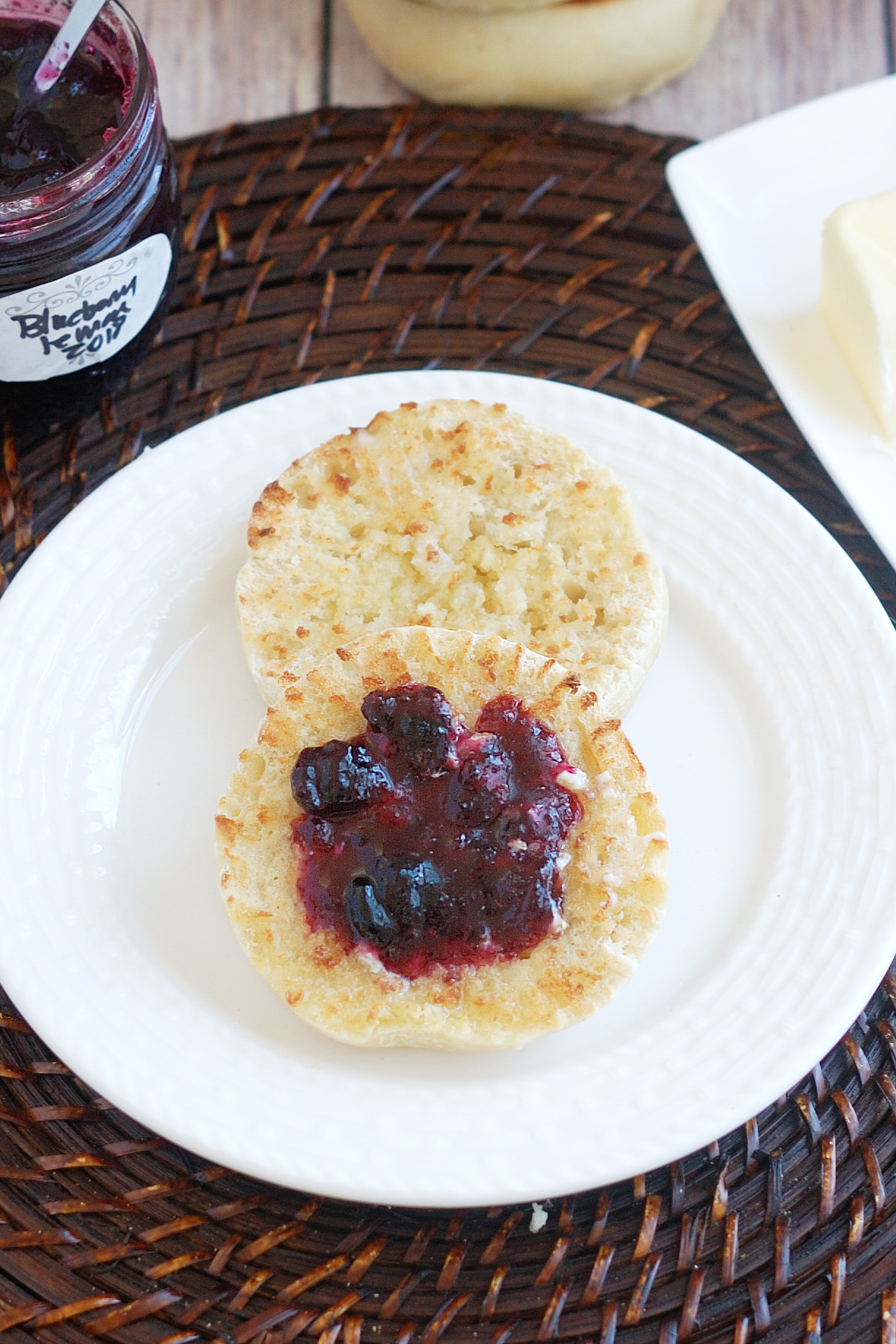
If you love this recipe as much as I do, please leave a 5-star review.
Sourdough English Muffin Recipe
Ingredients
- 8 oz active sourdough starter (1 cup, 100% hydration)
- 6 oz warm water (¾ cup)
- 8 oz whole milk (1 cup, scalded and cooled.)
- 25 oz unbleached all-purpose flour (5 cups, see note)
- 3 oz honey (¼ cup)
- 2 oz vegetable oil (¼ cup)
- 2 teaspoons salt
- cornmeal (for rolling)
Instructions
- Combine 8 oz active sourdough starter, 6 oz warm water, 8 oz whole milk and 2 cups (10 oz) of the flour in the bowl of a stand mixer or a large mixing bowl. Mix on low speed until combined. Cover the bowl and set aside for 30 minutes.
- Add 3 oz honey, 2 oz vegetable oil and 2 teaspoons salt and mix to combine. Switch to the dough hook if using a stand mixer. Add the remaining 3 cups (15 oz) flour and knead about 5 minutes or until the dough clears the sides of the bowl and clings to the hook. If mixing by hand, add flour until you can no longer stir, then turn the dough out onto a floured surface to finish by hand.
- Transfer the dough to a lightly oiled bowl, turning once to coat the dough. Cover the bowl and set it aside at room temperature. After 60 minutes uncover the bowl, lift one side of the dough over into the middle of the dough. Repeat with the other three sides of the dough then flip the dough over. Cover the bowl and after 60 minutes repeat the procedure. Cover the bowl and after 60 minutes repeat the procedure one last time. By now the dough should be lively, elastic and airy. If the dough is still sluggish give it another hour or two at room temperature. At this point the dough can be refrigerated for up to 2 days.
- Turn the dough from the bowl and knead briefly to form a smooth ball. Lightly sprinkle your work surface with cornmeal. Roll the dough to 1/2” thick. Cut muffins with a 3” biscuit cutter. Reroll the scraps and continue cutting until all the dough is used. You should get about 16 muffins. Place the muffins on an ungreased baking sheet. Cover the pan. (At this point the muffins can be refrigerated overnight and baked in the morning or continue to finish the muffins the same day.) Let the muffins rise until almost doubled in volume, about 1 hour.
- Preheat a griddle or cast-iron pan over medium-high heat. Reduce the heat to medium-low. Set the muffins, cornmeal side down in the pan. Place as many muffins as will fit in the pan with a 1" space between. "Bake" the muffins for about 6-8 minutes until the bottom is deep golden brown. Flip the muffins and bake until the other side is nicely browned. Keep an eye on the heat so the muffins don't burn. Adjust the heat as needed. Cool on wire rack. To serve, split and toast.
Would you like to save this recipe?
As an Amazon Associate and member of other affiliate programs, I earn from qualifying purchases.



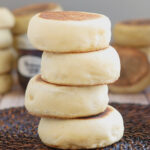





My starter is NOT equal weights hydration – it’s the King Arthur version, so half as much water as flour added to feed.
I think this is why a lot of my recipes are dense and the dough dry. How do I compensate for this?
Hi Jenn, You can use any hydration starter as long as you adjust the water and flour in the recipe for the difference. In my recipes I always use 8 oz of starter. Since my starter is 100% hydration that means the 8 oz of starter adds 4 oz of water and 4 oz of flour to the recipe. So if your starter is half as much water as flour (by weight?) then if you use 6 oz of starter that would mean you’re adding 4 oz of flour and 2 oz of water. So you can use my recipe but will need to add 2 oz of water to the dough to compensate for the lower hydration starter. Hope that helps.
I am currently cooking my muffins. I am noticing they are spreading out instead of rising. I followed directions exactly.
The ingredients was a little confusing. I divided the 500 g of flour by 5 so I can add the 2 cups like stated. But I noticed when i used my measuring cup 240g was not 2 cups it was less. So should we measure out by weight or a measuring cup?
Also I noticed they brown faster than the insides cooked. I have my stove on low and the skillet is covered.
Measure either by volume (cup) or weight. No need to do both. Weight is always the most exact. I just provide volume, metric and US measures so everyone can measure the way that works best for them. If they’re browning too fast you’ll need to lower the heat. I don’t cover the pan while they’re cooking. That could be why they’re getting too hot.
Does the starter need to be active? I’ve got loads of discard in the fridge that I want to use up but it’s unfed.
Hi Selina. Yes, the starter should be active. If you use discard that hasn’t been fed the dough will be sluggish and you won’t get enough lift to for the open crumb. I have a whole collection of recipes that use sourdough discard. If you’re a chocoholic I highly recommend the brownies.
Can you use 2% milk in this recipe
Yes.
I have tried 3 or 4 different recipes for sourdough, including this one, and for every one of them the dough I am being left with is ridiculously soft- unkneadable without substantial extra flour. Am I doing something wrong?
A lot of sourdough recipes create a dough that is significantly wetter than typical “yeasted” bread dough. It does take some getting used to. Also, make sure your starter is the same hydration as the recipe specifies. I use a 100% hydration starter (fed equal weights of starter-water-flour). If your starter is wetter than your dough will be wetter.
Hi! I’m new to sourdough and have only made sourdough focaccia so far but this is my next step. I have half and half in the fridge and am avoiding the store because of the current pandemic, would that work or should I cut it with a little water?
Yes, that should be fine. I would say half 1/2&1/2 and half water would work.
Hello! I was so excited to find your recipe! However, my dough won’t form into a ball. I’m not sure what to do. I did everything as stated so far. Except testing a bit of sour dough starter in liquid before starting! ♀️ Didn’t see that until I had everything mixed. Can you help?? I’ve added four 1/4 cups of flour after the 5 cups the recipe called for. Like you do when the dough ain’t setting up. So I’m up to 6 cups of flour total. I wish I could post a picture so you could see. I don’t know how to proceed.
Isn’t not ain’t ♀️
Are you using a stand mixer? Are you using a 100% hydration starter (equal weights starter-water-flour) With sourdough, even if the dough is quite sticky to start, after several hours of fermentation the dough should come together. I would stop adding flour and set it aside to rise. I see that this comment is from last night. How did it work out?